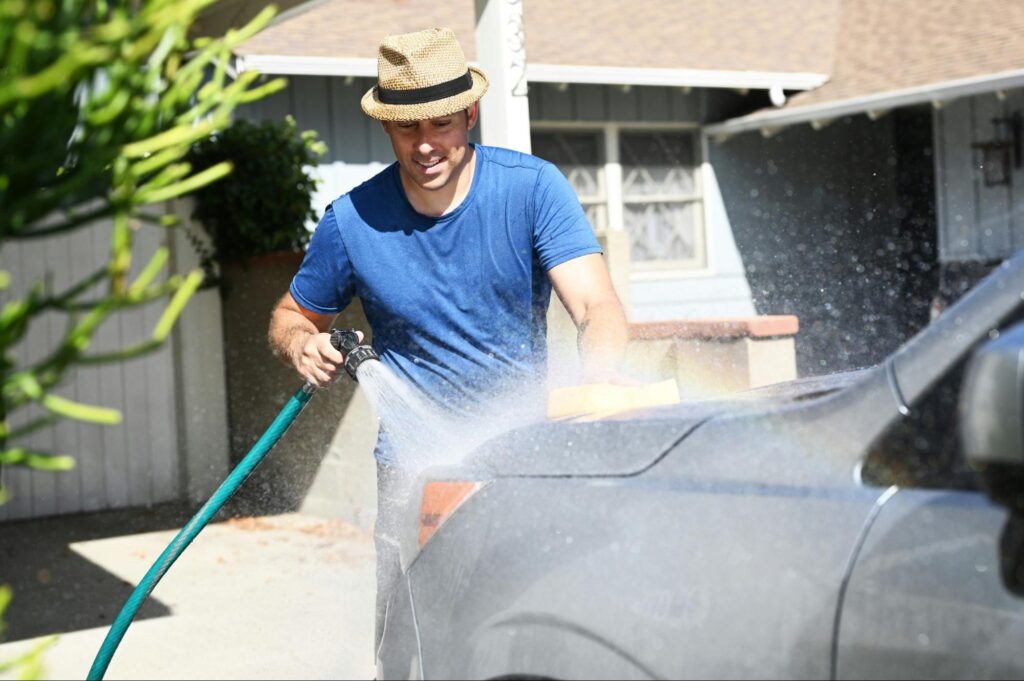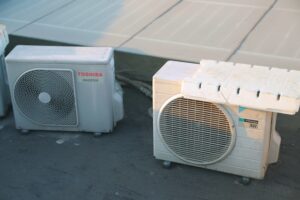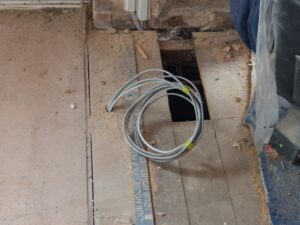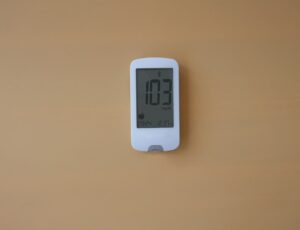Adding a hot and cold hose bib in your garage can greatly enhance your home’s functionality, especially during the colder months.
With a hot and cold hose bib, you can wash your car, fill containers with warm water, or clean your garage without worrying about freezing pipes. This simple upgrade helps maintain a cleaner and more efficient workspace in your garage.
Excel Mechanical is your go-to expert for this upgrade. We specialize in tailoring HVAC and plumbing solutions that fit your needs and budget. Our expertise ensures you receive the highest-quality installation, ensuring your garage hose bib is functional and durable.
A hot and cold hose bib is a practical addition for tackling home projects or improving garage efficiency. With the right installation by professionals, you can enjoy long-lasting performance and reliability in managing your water supply efficiently in any season.
In this blog, we will talk about:
- The benefits of adding a hot and cold hose bib to your garage.
- How Excel Mechanical ensures a seamless and efficient installation.
- Key considerations and step-by-step guidance for a successful installation.
Let’s break it down!
Overview of Hose Bibs
Hose bibs, also known as outdoor faucets, are essential for controlling water access outside the home. They are convenient for watering gardens, washing cars, or filling buckets in garages.
Definition and Purpose
A hose bib is a valve that allows you to turn water on and off outside your home.
It’s an important fixture that provides a connection point for your garden hose. Most homes have at least one hose bib, often located in the backyard or garage.
These fixtures help manage efficient outdoor water use. They are designed to withstand various weather conditions, ensuring durability and reliable performance.
Quality matters, so choosing the correct hose bib for your needs is crucial.
Types of Hose Bibs
There are several types of hose bibs, each with specific features.
- Standard hose bibs are the most common, offering basic functionality for everyday use.
- Frost-free hose bibs are designed for cold climates. They have a valve inside the house to prevent freezing in the winter months.
- Another option is the anti-siphon hose bib, which includes a backflow prevention feature. This type ensures that water does not flow back into your home’s plumbing, keeping it safe from contamination.
Hot and Cold Hose Bibs
Installing hot and cold hose bibs in your garage can significantly enhance your daily tasks and household projects. This setup allows you access to hot and cold water, making it more convenient for various applications.
Benefits of Having Both Hot and Cold Water
Having hot and cold water in your garage can make a big difference.
- Hot water is perfect for cleaning greasy tools and equipment. It removes tough stains and loosens dirt more effectively than cold water alone.
- On the other hand, cold water is excellent for quick rinses or filling storage tanks and containers.
Additionally, using hot water to wash your car can help cut through grime faster. This means less time spent scrubbing. Cold water is also helpful for filling up pools or kiddie baths during hot weather. This versatility reduces the need to run inside the house, saving you time and effort.
Usage Scenarios for Hot and Cold Water in a Garage
In your garage, having access to hot and cold water opens up various possibilities.
For instance, hot water can wash mud off boots or clean pet areas. This ensures better hygiene and helps maintain cleanliness in your home.
For DIY enthusiasts, hot water can help mix cleaning solutions or soften adhesives. Cold water is helpful for gardening tasks or for washing off painting tools easily.
Design Considerations for Garage Hose Bibs
Several important factors impact performance and longevity when installing hose bibs in a garage. Key aspects include selecting the right materials, choosing the correct valve types, and determining the best installation location.
Material Selection
Choosing the right material for hose bibs is crucial.
High-quality materials like brass or stainless steel are popular because they resist corrosion and withstand various temperatures.
- Brass is highly durable and resistant to damage from heat and water exposure.
- Stainless steel offers strength and resistance to rust, making it ideal for areas with high moisture.
Consider potential exposure to harsh chemicals or environmental conditions in the garage. This ensures that the selected material will maintain integrity over time without frequent replacements.
Valve Types and Their Advantages
Different valve types offer unique benefits.
- Ball valves are known for their durability and ease of use. They allow water to be controlled with a simple quarter turn and provide a tight seal, which prevents leaks.
- Gate valves, although more traditional, control water flow effectively and are suitable for precise regulation.
- If temperature control is essential, consider mixing valves. These allow hot and cold water to be poured directly into the bib, offering more versatility.
Choose a valve type that best suits your usage requirements and water flow preferences.
Installation Location
Identifying the optimal installation spot in the garage is critical for functionality and convenience.
Ensure the hose bib is easily accessible and protected from potential damage. Placing it near garage entry points can make it more convenient to reach.
Consider the elevation and distance from primary water supply lines to reduce plumbing needs. Consider external factors like freezing temperatures. Insulating the pipes can prevent damage from cold weather.
Installation Guide
Installing a hot and cold hose bib in your garage can boost the functionality of your work area. This guide will assist you in gathering the necessary tools, following a step-by-step installation process, and ensuring safety throughout the process.
Tools and Materials Required
To begin, gather all necessary tools and materials.
You’ll need a drill, pipe wrench, and pipe cutter. Additionally, have plumber’s tape, copper or PEX pipes, and two hose bibs—one for hot water and one for cold.
Important items:
- Drill and drill bit
- Pipe wrench
- Plumber’s tape
- Copper or PEX pipes
- Two hose bibs (hot and cold)
Ensure that you have all items before starting to avoid interruptions. This preparation allows for a smoother installation.
Step-by-Step Installation Process
- First, turn off the water supply to prevent leaks.
- Next, use the drill to create holes where the hose bibs will be mounted. Ensure they are correctly aligned with the plumbing inside your garage walls.
- Using a pipe cutter, cut the pipes to the needed length.
- Attach the pipes to the hose bibs, ensuring a secure fit, and seal the joints with plumber’s tape to prevent leaks.
- Then, connect the pipes to the existing water lines, using appropriate connectors for copper or PEX.
- Test the connections by turning the water supply back on and checking for leaks or pressure issues.
Safety Precautions
Safety should be your priority during installation.
- Always turn off the water supply before beginning work.
- Use appropriate eye protection when drilling or cutting pipes to protect your eyes from debris.
- Ensure all tools are in good condition to reduce the risk of accidents.
- Follow local building codes and regulations to avoid any legal issues.
- Seek professional help if needed to ensure a safe installation.
Excel Mechanical provides expert HVAC and plumbing services, ensuring your installation meets high standards. Our team is committed to delivering quality solutions tailored to your needs and budget.
Maintenance and Troubleshooting
Proper maintenance and troubleshooting of your garage hose bib ensure it works well and lasts longer. Regular check-ups can prevent leaks and common issues, making your system reliable.
Regular Maintenance Tasks
Regular upkeep is key to keeping your hose bibs in good shape.
- Start by inspecting for any leaks, as even small drips can lead to bigger problems. Tighten any loose connections and replace worn-out washers.
- During the colder months, insulate exposed pipes to avoid freezing. Wrap them in heat tape or use foam covers to protect against low temperatures. This helps maintain water flow and prevents bursts.
- Make it a habit to clean the bib. Clear away dirt or debris that might block water flow. Periodically, check for rust or corrosion, especially in metal components, and treat them promptly to avoid damage.
Common Issues and Solutions
- One frequent problem is leaks around the bib. If you spot a leak, it might be due to loose fittings or a worn-out washer. Tighten connections or replace washers to resolve this.
- Another issue is reduced water flow, often caused by mineral buildup or debris. Removing the bib and cleaning internal parts can restore normal flow.
- If pipes freeze, a lack of insulation is usually the cause. Consider insulating these areas to prevent future freezing. If bursts occur, it’s crucial to repair them swiftly to prevent water damage.
Regulations and Compliance
When installing hot and cold hose bibs in your garage, it is crucial to adhere to building codes and consider winterization needs. Proper installation ensures safety and efficiency. Below, we detail relevant regulations and tips.
Building Codes and Standards
When installing a hose bib in your garage, you must comply with local building codes.
Codes ensure safety and functionality. Common standards may cover materials, placement, and connections for plumbing systems. These requirements help prevent leaks and damage.
Familiarize yourself with plumbing codes specific to your area. This includes ensuring the hose bib is installed at the correct height and using materials approved for your region’s climate. Consult your local government or a professional for specific guidelines.
Winterization and Temperature Factors
In colder climates, winterization is essential to prevent hose bibs from freezing.
Insulate pipes and use frost-free hose bibs to avoid burst pipes and expensive repairs. These preventative steps ensure your system operates smoothly year-round.
Install heat tape or insulation sleeves on exposed pipes to protect them from harsh temperatures. Disconnect and drain hoses not in use during winter to reduce the risk of freezing.
Product Selection
When choosing a hot and cold hose bib for your garage, several factors, such as brand reputation, functionality, and budget, need careful attention. Making informed choices can enhance your convenience and meet specific needs.
Evaluating Different Brands and Models
It’s crucial to compare brands to find one that suits your needs.
Excel Mechanical stands out by offering reliability and quality in its range of hose bibs, making it ideal for residential and commercial applications. Different brands provide various features, so check the user reviews and performance ratings.
Consider models known for durability and ease of installation. Some reputable models are designed with anti-freeze technology, which can prevent your hose bib from freezing during colder months.
It’s crucial to check warranty terms and customer service support to ensure you have assistance if needed.
Features to Look For
When selecting a hot and cold hose bib, focus on features that enhance functionality and longevity.
- Look for models with dual shut-off valves, allowing you to control hot and cold water independently.
- Valves with anti-siphon or backflow prevention capabilities are essential for maintaining water safety. Durability should be a top priority, so opt for brass or stainless steel that resists corrosion.
- Consider hose bibs with comfortable, easy-to-turn handles, even in cold weather.
Cost Considerations
Budgeting for a hot and cold hose bib involves evaluating both the initial purchase cost and the long-term value. Prices vary, but ensuring you get quality for your money is vital.
Factor in potential installation expenses if you require professional help. Investing more up front in a quality hose bib can save you from frequent replacements or repairs. Look for promotions or discounts that may be available, which can make higher-end models more affordable.
Environmental Impact and Sustainability
When installing hot and cold hose bibs in your garage, consider their environmental impact. Focus on water conservation techniques and energy-efficient models to reduce your ecological footprint while enhancing utility and cost-effectiveness.
Water Conservation Techniques
Implementing water conservation techniques helps preserve this precious resource.
- Consider installing low-flow hose bibs, which reduce water usage without sacrificing performance. Additionally, ensure that all fittings and connections are tight to prevent leaks.
- Another helpful approach is using shut-off nozzles on hoses. They control water flow more effectively and prevent waste.
- Also, a rainwater collection system should be considered for watering gardens or cleaning tasks. Rain barrels can be connected to your hose bibs, providing a sustainable water source for non-drinking purposes.
- Monitoring your water usage is also beneficial. Keep an eye on water bills and usage patterns. This helps identify excessive use or potential leaks in your system.
Staying proactive about conservation not only aids the environment but also saves you money.
Energy-efficient Models
Choosing energy-efficient models for your hose bibs reduces energy consumption and saves money. Look for hose bibs with insulated handles or frost-proof features. These can help maintain water temperature and reduce heat loss.
Consider models that integrate with your home’s water heater efficiently. This ensures minimal energy loss when heating water for your garage’s needs. Excel Mechanical offers top-tier, energy-efficient solutions tailored to your precise requirements, ensuring optimal performance.
Always select products with high efficiency ratings. This includes checking for any certifications or ratings that indicate energy-saving capabilities. By prioritizing energy-efficient models, you can balance functionality and sustainability, providing long-term benefits for your home and the environment.
Excel Mechanical is committed to delivering these high-quality, sustainable solutions for residential and commercial needs.
Frequently Asked Questions
Adding a hot and cold hose bib in your garage might sound like a small upgrade, but it’s packed with benefits that can make a huge difference in your day-to-day tasks. Let’s answer some common questions that can help you decide if this upgrade is right for you!
What are the benefits of installing a frost-free hot and cold hose bib in a garage?
A frost-free hot and cold hose bib allows for year-round accessibility to temperature-controlled water in your garage. This is particularly useful for tasks like washing cars or cleaning tools without worrying about the water lines freezing in winter.
How does a single-handle hot and cold outdoor faucet work?
A single-handle faucet combines hot and cold water through one spout, with the handle adjusting the temperature. Turning it one way increases the hot water flow, while the other way boosts cold water, allowing precise control with a simple motion.
What factors should be considered when choosing the best hot and cold hose bib for a garage?
Key factors to consider include material durability, frost-free features, and ease of use. Ensure compatibility with your piping system, and consider a model that offers easy installation and maintenance. Always choose a model suitable for your local climate conditions.
At what temperature should I be concerned about a hose bib freezing, and how can I prevent it?
Hose bibs can freeze at temperatures below 32°F. To prevent freezing, consider using an insulated cover or heat tape. Disconnect and drain hoses when not in use to protect against freezing damage.
How do I properly install a hot and cold hose bib using PEX piping?
To install a hot and cold hose bib with PEX piping, cut and fit the PEX to the bib’s connections using appropriate fittings. Secure all connections and test for leaks. Following proper installation techniques ensures a reliable and durable setup.
What are some reputable brands or retailers where I can find a heavy-duty hot and cold hose bib for my garage?
Excel Mechanical offers high-quality hose bibs tailored to meet various needs and budgets. Our dedication to exceptional quality makes us a trusted choice in HVAC and plumbing solutions for both residential and commercial uses.




